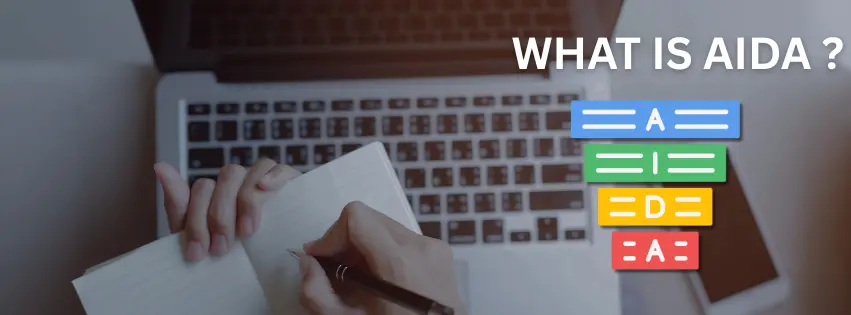
What is AIDA?
If you've ever studied copywriting, chances are you've heard of AIDA. It's one of the oldest and most reliable frameworks in the game—used in everything from 1960s print ads to today's high-converting email funnels.
But here's what most beginners miss: AIDA isn't just a formula. It's a map of your reader's journey—from that first spark of curiosity to the final "I need this" click. When done right, it feels effortless. The reader doesn't feel pushed. They feel pulled in.
Each letter in AIDA stands for a psychological step:
- Attention: Grab their focus—instantly.
- Interest: Stoke curiosity. Give them a reason to keep reading.
- Desire: Build emotional resonance. Make them want it.
- Action: Make the next step obvious—and easy.
Simple? Yes. But mastering AIDA is what separates forgettable messages from content that converts.
When Should You Use the AIDA Framework?
AIDA is perfect when you need to grab attention fast — especially when speaking to cold audiences who don't yet know your brand.
It's most effective in:
- Ad copy: Where space is tight and first impressions are everything.
- Email subject lines + openers: You need to stop the scroll, then lead curiosity toward action.
- Landing pages: AIDA creates a logical emotional flow that warms up visitors to say "yes."
- Product descriptions: Especially for impulse-buy or low-commitment products.
In short, anytime you need to guide a reader from "What's this?" to "I want that!", AIDA is a strategic fit.
How to Write with the AIDA Framework (Step by Step)
AIDA isn't just theory — it's a practical, repeatable formula. Here's how each step works in real copy:
1. Attention – Grab Their Eyes
The goal here is simple: stop the scroll. Whether it's a bold headline, a striking visual, or a provocative question,
you want your audience to pause and pay attention.
Examples: "Still writing emails that no one opens?" or "What if 1 sentence could triple your conversions?"
2. Interest – Feed Their Curiosity
Now that you've got their attention, don't waste it. Hook their mind by diving into a relatable pain point,
a surprising insight, or something that makes them think, "I need to read more."
Tip: Speak their language. Use short sentences. Build tension.
3. Desire – Stoke the Emotion
Here's where you make them want the thing you're offering. Paint the benefit vividly.
Let them imagine their life after using your product or solution.
nstead of "We offer 24/7 support," say "Never feel stuck again — our team has your back anytime, anywhere."
4. Action – Tell Them What to Do Next
This is where many people fall short. Don't assume they'll just "know." You need to clearly, confidently
tell them what step to take. "Buy now," "Claim your free trial," or even "Let's talk."
Pro Tip: Use buttons or bold CTAs. One message, one action.
AIDA in Action: Real Ad Copy Example
Let's put AIDA to the test in a real-world scenario — say, promoting a skincare product.
- 🅰 Attention: "Tired of dull, tired-looking skin?"
- 🅸 Interest: "GlowUp combines Vitamin C + Niacinamide to gently brighten and restore your skin's natural glow — all in just 7 days."
- 🅳 Desire: "Thousands have regained confidence with softer, more radiant skin — without harsh chemicals or expensive treatments."
- 🅰 Action: "Get 20% off your first order – only this week. Claim Your Glow →"
This structure works across products, industries, and formats — from email and landing pages to TikTok scripts and sales decks. Once you understand the rhythm, you'll start seeing AIDA everywhere.
Common Pitfalls with AIDA
While AIDA is powerful, it's easy to misuse. Many writers fall into the trap of treating each step like a checklist—robotic and forced. That kills flow and makes the copy feel… AI-generated (ironically).
- Overhyping Attention: Don't shout for attention. Intrigue works better than exaggeration.
- Flat Interest: Interest isn't just facts. It's insight—something that makes the reader nod or say, "That's me."
- Desire Without Emotion: Benefits are logical. Desire is emotional. Always tap into feelings.
- Weak CTA: "Click here" is not a CTA. Make the next step meaningful and aligned with the story.
The best AIDA doesn't look like AIDA. It reads like a smooth, persuasive story that just makes sense.
AIDA vs. Other Frameworks
Is AIDA always the best choice? Not necessarily. It shines in short-form, direct-response copy—but other frameworks offer different strengths.
| Framework | Best For |
|---|---|
| AIDA | Ads, product pages, landing pages |
| PAS | Problem-solution sales copy, persuasive intros |
| PASTOR | Story-based emails, long-form sales pages |
| BAB | Before/after transformations (great for email) |
Think of AIDA as your "go-to hammer." Just remember—it's not the only tool in the box.
Why I Still Use AIDA in 2025 (Despite All the Hype)
Let's be honest—new frameworks pop up every year. But AIDA still earns its place in my writing toolkit.
When I'm stuck staring at a blank page, I go back to basics: grab attention, hold interest, spark desire, drive action. It clears the fog. It gets the draft moving. It reminds me to respect the reader's mental journey.
Sure, I'll adapt it. Sometimes the Interest and Desire parts blend together. Sometimes the CTA comes earlier. That's fine. The point is: AIDA helps you think like the reader. And that never goes out of style.
Mastered AIDA? Let's Go Deeper →
You've just learned one of the most powerful frameworks in copywriting history. But that's just the beginning.
Explore our full library of frameworks, email sequences, storytelling blueprints, and CTA vaults – all designed to help you write copy that actually converts.
Visualizing the AIDA Flow
- Attention → Grab
- Interest → Engage
- Desire → Make Them Want
- Action → Drive Response
Each step must flow into the next—naturally, emotionally, and logically.


